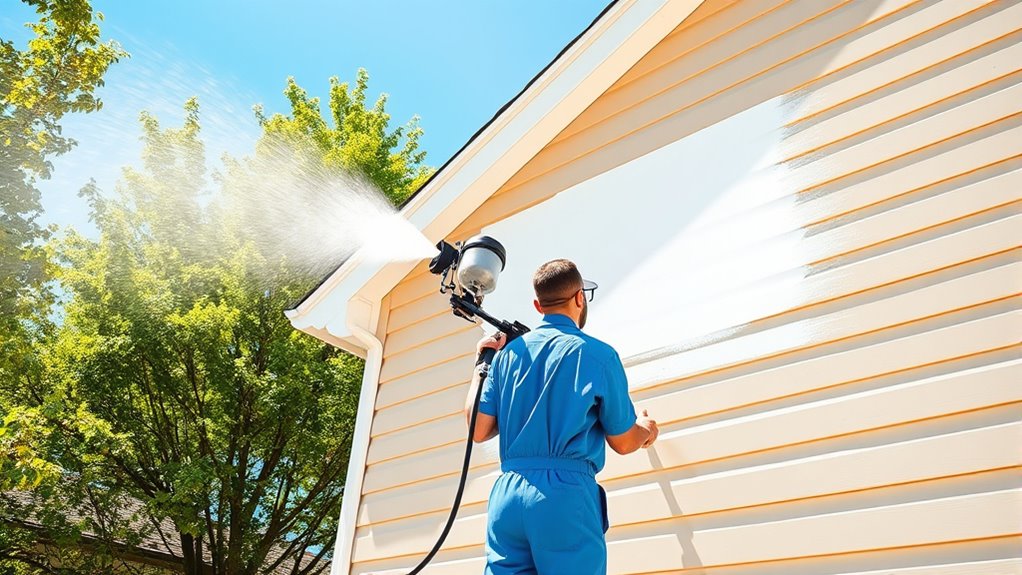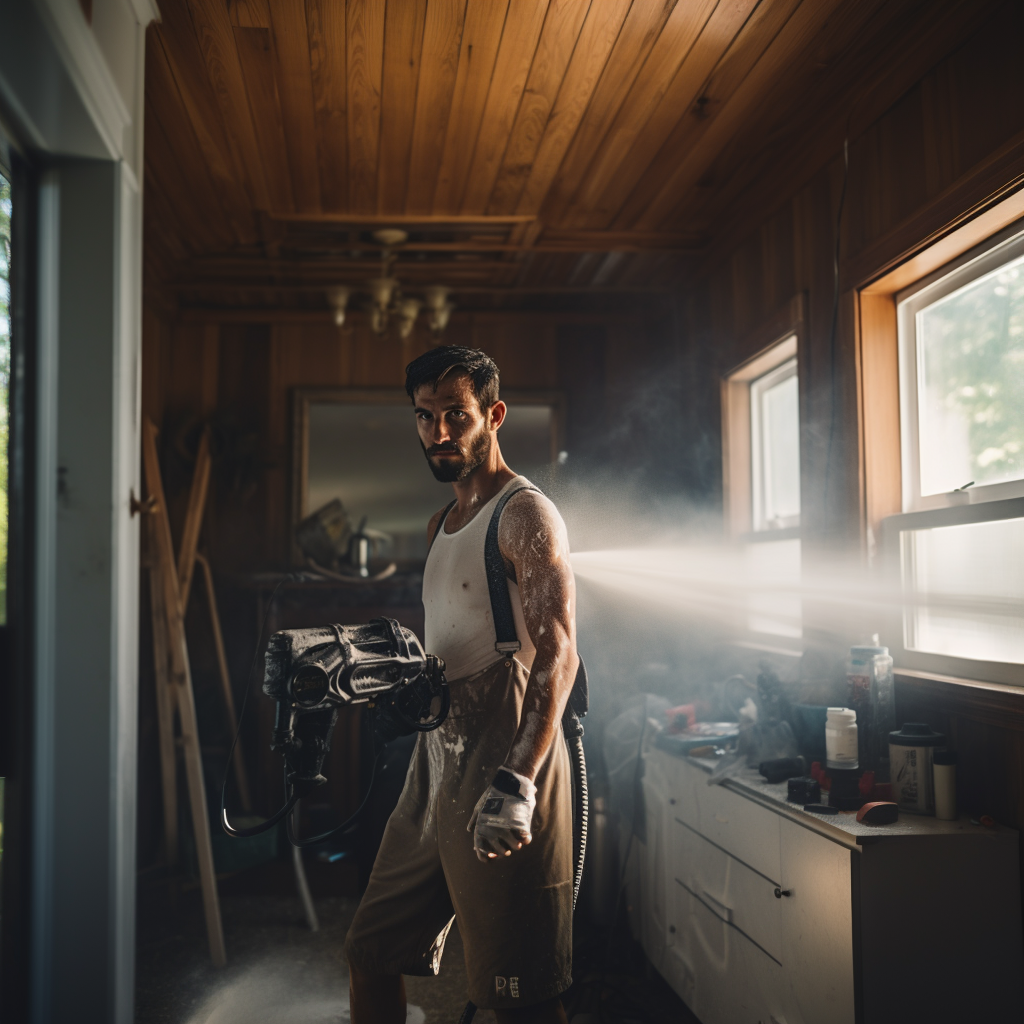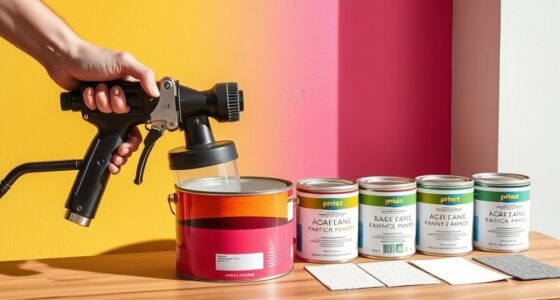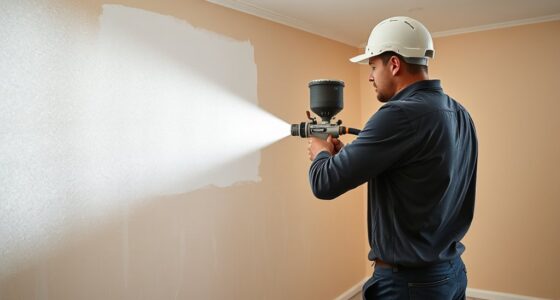To speed up house painting with a sprayer on exterior siding, start by preparing the surface thoroughly—clean, dry, and smooth. Adjust your sprayer to the right pressure, keep it 10-12 inches from the siding, and overlap each pass slightly for even coverage. Protect surrounding areas with drop cloths and wear safety gear. Using proper technique guarantees a smooth, professional finish quickly. Keep these tips in mind; more details can help you master the process effectively.
Key Takeaways
- Adjust sprayer pressure properly to ensure even coverage and prevent overspray.
- Maintain a steady, consistent distance of 10-12 inches from the siding during spraying.
- Overlap each pass slightly to avoid streaks and achieve uniform paint application.
- Cover surrounding areas with drop cloths to protect surfaces and minimize cleanup.
- Practice on scrap or inconspicuous areas to perfect technique before full application.
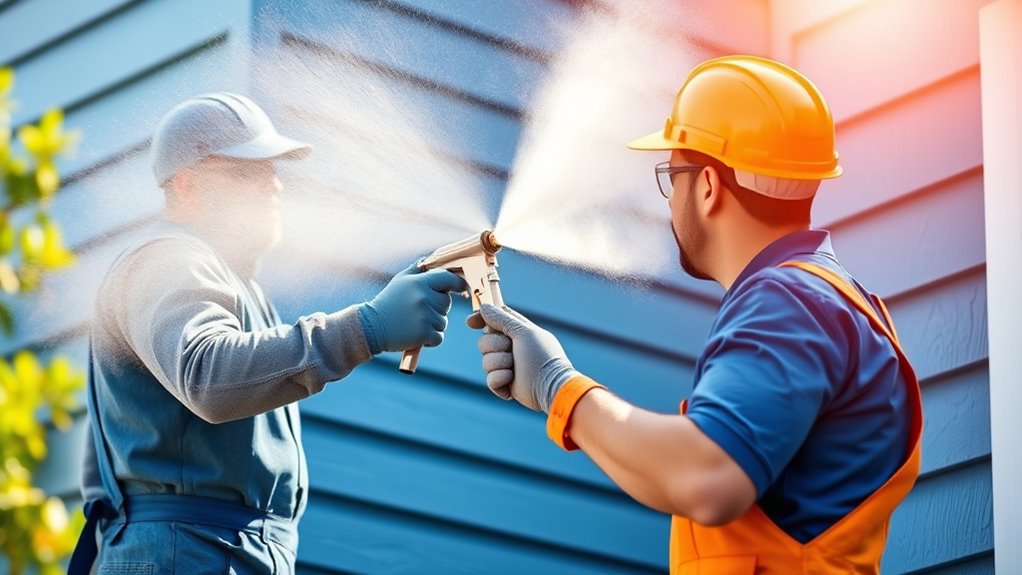
Painting the exterior siding of your home can be a time-consuming and labor-intensive task, but using the right paint sprayer can make it much easier and faster. When you’re preparing to tackle this project, focus on proper paint preparation first. This means cleaning the siding thoroughly to remove dirt, mold, and loose paint. You might need a pressure washer for stubborn grime, ensuring the surface is smooth and free of debris. Once cleaned, let the siding dry completely before moving forward. Proper paint preparation guarantees better adhesion and a more even finish, which is vital when using a sprayer. Additionally, selecting the right type of paint suitable for exterior siding helps prevent chipping and fading, extending the lifespan of your paint job.
Before you start spraying, it’s essential to master your brush techniques. Even though a sprayer covers large areas quickly, some spots—like corners, edges, or tight spaces—are easier to handle with a brush. Using a high-quality brush, you should apply thin, even coats, working carefully to prevent drips and uneven coverage. Consistent brush strokes help blend the sprayed paint seamlessly with the areas you’ve brushed, ensuring a uniform look. Practice your brush technique on a scrap piece or an inconspicuous section to get a feel for the right pressure and stroke length. This prep work minimizes mistakes and helps you achieve a professional-looking finish.
When you’re ready to spray, set your sprayer to the appropriate pressure level—too high can cause overspray and drips, while too low may result in uneven coverage. Keep the sprayer moving steadily, maintaining a consistent distance from the siding—usually about 10 to 12 inches. Overlap each pass slightly to avoid streaks. Remember, even if the sprayer does most of the work, your brush techniques and paint preparation lay the foundation for a smooth, professional-looking finish. Cover nearby surfaces with drop cloths or plastic sheeting to protect them from overspray, and wear protective gear like goggles and a mask to stay safe.
Frequently Asked Questions
What Types of Paint Are Best Suited for Exterior Siding?
For exterior siding, you should choose high-quality acrylic latex paints. They guarantee excellent paint adhesion and flexibility, which helps prevent cracking or peeling over time. These paints also offer better color longevity, maintaining vibrancy longer. When selecting paint, look for one specifically formulated for outdoor use, as it’s designed to withstand weather conditions, ensuring your siding stays protected and looking great for years to come.
How Do I Clean and Maintain My Paint Sprayer?
Think of your sprayer nozzle as the heartbeat of your painting tool. To keep it pounding smoothly, you need regular maintenance. After each job, flush the system with solvent cleaning to wash away paint residue, preventing clogs and ensuring flawless spray patterns. Carefully disassemble the nozzle and clean every part, inspecting for wear. Proper care keeps your sprayer humming like a well-oiled machine, ready for your next project.
Can I Use a Paint Sprayer on Textured or Uneven Surfaces?
You can definitely use a paint sprayer on textured or uneven surfaces, but proper surface preparation is key. Make sure the surface is clean, dry, and free of debris to guarantee even coverage. Check your sprayer compatibility—some sprayers work better on rough surfaces than others. Use the right tip size and pressure settings for textured areas to avoid overspray and achieve a smooth, professional finish.
What Safety Precautions Should I Take During Spraying?
They say safety always comes first, and that’s especially true when spraying paint. You should wear protective gear like goggles, gloves, and a mask to avoid inhaling fumes or getting paint in your eyes. Also, make certain proper ventilation precautions are in place—work outdoors or open windows—to prevent inhaling harmful vapors. Taking these steps keeps you safe and helps you complete your project smoothly and efficiently.
How Do I Ensure an Even Coat Without Drips or Streaks?
To guarantee an even coat without drips or streaks, focus on proper brush techniques and maintaining the right paint thickness. Keep your spray tip at a consistent distance from the siding and use smooth, overlapping passes. Thin the paint if needed to prevent runs, and avoid applying too much at once. Regularly check your work and adjust your technique to achieve a professional, streak-free finish.
Conclusion
Using a paint sprayer for your exterior siding can make your house painting faster and more efficient. With a little practice, you’ll achieve smooth, even coverage that transforms your home’s look in no time. Imagine the satisfaction of finishing your project quickly and enjoying your refreshed home. Isn’t it worth trying a sprayer to see how much easier and faster painting can be? Embrace the tool, and watch your house come to life with vibrant new colors!
Franz came aboard the Paint Sprayer Zone team with a background in both journalism and home renovation. His articulate writing style, combined with a passion for DIY projects, makes him an invaluable asset. Franz has a knack for breaking down technical jargon into easy-to-understand content, ensuring that even the most novice of readers can grasp the complexities of paint sprayers.
